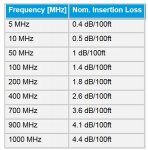Looking for advice on something. I have a desk on one of a side of a room and run about 20 feet of coax to an lna with a moxon antenna in the front window.
I have read the moxon is 50 ohm. The 20 feet of cable I am using is F677TSVV (spec sheet) Its listed as 75ohm. I am only receiving for scanner and sdr and mostly use the moxon.
Question is for anyone can read the spec sheet and let me know if this stuff is any good. I don't know about this stuff. It's what I had at the time but if it sucks, I will replace with what's recommended. Like I said, I do not transmit at all, just scanner / sdr for 7/800, 470, airband and vhf. I just want the best possible reception, like everyone else.. What would my coax be compared to?
Thanks.
I have read the moxon is 50 ohm. The 20 feet of cable I am using is F677TSVV (spec sheet) Its listed as 75ohm. I am only receiving for scanner and sdr and mostly use the moxon.
Question is for anyone can read the spec sheet and let me know if this stuff is any good. I don't know about this stuff. It's what I had at the time but if it sucks, I will replace with what's recommended. Like I said, I do not transmit at all, just scanner / sdr for 7/800, 470, airband and vhf. I just want the best possible reception, like everyone else.. What would my coax be compared to?
Thanks.




